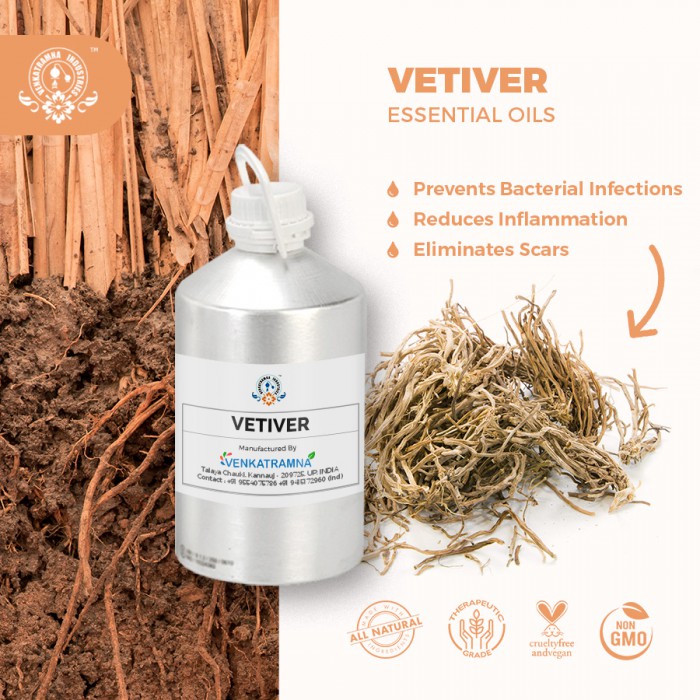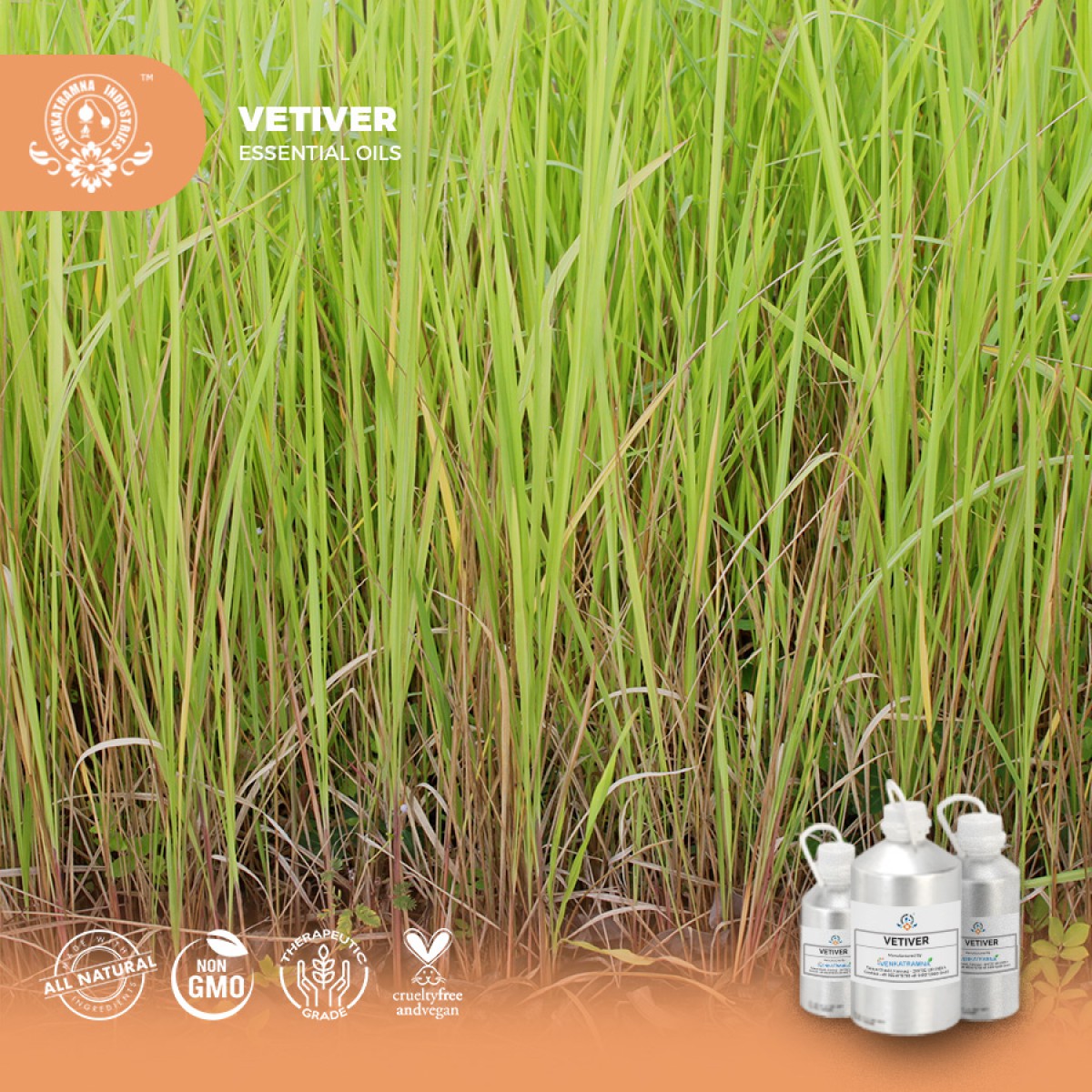Botanical Name: Vetiveria Zizanoides (Chrysopogon zizanioides) Common name: Ush Read More
|
Botanical Name: |
Vetiveria
Zizanoides (Chrysopogon zizanioides) |
|
Common name: |
Ushira |
|
Plant
family: |
Poaceae |
|
Genus: |
Vetiveria |
|
Appearance/Color: |
Medium
consistency, and is a brown to reddish brown liquid. |
|
Odor: |
A base note with a
strong aroma, has an earthy, woody scent characteristic of oils derived from
roots, with a rich note that is popular in products designed for men. |
|
Blends With: |
Cedarwood,
Chamomile, Frankincense, Ginger, Jasmine, Juiper, Lavender, Lemongrass,
Patchouli, Rose, Sandaalwood, Spikenard, Vanilla and Ylang-Ylang. |
|
Origin: |
Indonesia |
|
Source: |
Roots |
|
Method
of Extraction: |
Steam
Distillation |
Vetiver essential oil (VEO) is
produced by steam distillation of the aromatic roots of the tropical
grass Vetiveria zizanioides, which is native to the Indian
subcontinent. VEO has a long history of use primarily due to its
insect-repellent property and persistent green-woody note. Scientific studies
have evaluated its insect-repellent, anti-inflammatory, antioxidant, and
metabolic activities.
Ushira (Vetiver) is known as nectar in summers as it lightens all health issues related to heat and summer. The scientific name of the Ushira plant is Vetiveria zizanioides. It is famous with the name of khus. These are known as perennial grass that can grow up to one to two meters high with wide clumps. Ushira tillers are known as stem produced by grass plants. The clumps or tillers arise from rhizomes. The clumps can be grown up to 8 feet. These tillers are strong and stiff. The rhizomes are so small and do not run out. The lodging is very low in these. Roots of the plants are spongy, stout and strong type. These are with aromatic character. The root system of the plant is somewhat massive but compact, structured and very strong. It grows about 2 feet on both sides of the plant but it can acquire depth up to 8 feet. The leaves of the plant can grow up to 120 to 125 cm long and 0.8 cm wide. The leaves are narrow, keel and erect with rough margins. The inflorescence panicles are 15 to 30 cm long with 2.5 to 5.0 cm long whorl branches. These are purple brown in color. The spikelet are of grey, green or purple color, 1/8-1/4 inch long with three stamens.
DISCLAIMER
The complete range of conditions
or methods of use are beyond our control therefore we do not assume any
responsibility and expressly disclaim any liability for any use of this
product. Information contained herein is believed to be true and accurate however,
all statements or suggestions are made without warranty, expressed or implied,
regarding accuracy of the information, the hazards connected with the use of
the material or the results to be obtained from the use thereof. Compliance
with all applicable federal, state, and local laws and local regulations
remains the responsibility of the user.
The FDA has not evaluated the
statements on this website. No claims are made by Venkatramna Industries as to
the medicinal value of any products from vriaroma.com or by us. The information
presented here is for educating our customers about the traditional uses of
essential oils and is not intended to diagnose, treat, cure, or prevent any
disease. You are responsible for understanding the safe application of these products.
If you have any questions, please call or email us for further information.
As per NAHA guidelines, New Directions Aromatics
(NDA) does not recommend the ingestion of essential oils. It is imperative to
consult a medical practitioner before using Essential Oils for therapeutic
purposes. Pregnant and nursing women and those taking prescription drugs are
especially advised not to use this product without the medical advice of a
physician. The oil should always be stored in an area that is inaccessible to
children, especially those under the age of 7.
Vetiver (Vetiveria zizanioides)
essential oil (VEO) has a long history of use. However, research on its
biological activity in human skin cells is scarce. Vetiver essential oil (VEO)
is produced by steam distillation of the aromatic roots of the tropical
grass Vetiveria zizanioides, which is native to the Indian
subcontinent. VEO has a long history of use primarily due to its
insect-repellent property and persistent green-woody note. Scientific studies
have evaluated its insect-repellent, anti-inflammatory, antioxidant, and metabolic
activities.
V. zizanioides has
also been cultivated for many industrial applications, including the production
of the commercially and medicinally valued volatile oil that can be distilled
from its root. V. zizanioides essential oil (VZ-EO) has been
frequently used as a functional ingredient and fragrance in foods, aromatic
products, and cosmetics. The vetiver oil is an expensive edible oil in the
Chinese market and which has also been used in India in many ways as a food
additive, such as flavoring syrups, ice cream, and beverages and for food
preservation. Moreover, VZ-EO is commonly used as traditional medicine in
Thailand and India for the treatment of numerous syndromes, such as gastritis,
fever, headache, mouth ulcers, toothache, and chronic inflammation.
COMMON USAGE
·
Reduces inflammation
·
Eliminates scares
·
Prevents bacterial infections
·
Enhances libido
·
Acts as a tonic
·
Prevents nervous disorders
·
Relieves insomnia
·
Speeds-up healing
Ingredients:
|
S. No. |
Ingredients |
Strength (%) |
|
1 |
Khusimol (zizanol) |
3.4-13.7 |
|
2 |
Vetiselinenol (isonootkatol) |
1.3-7.8 |
|
3 |
Cylocopacamphan-12-ol (epimer A) |
1.0-6.7 |
|
4 |
a-cadinol |
0-6.5 |
|
5 |
a-vetivone (isonootkatone) |
2.5-6.4 |
|
6 |
b-vetivenene |
0.2-5.7 |
|
7 |
b-eudesmol |
0-5.2 |
|
8 |
b-vetivone |
2.0-4.9 |
|
9 |
Khusenic acid |
0-4.8 |
|
10 |
b-vetispirene |
1.5-4.5 |
|
11 |
g-vetivenene |
0.2-4.3 |
|
12 |
a-amorphene |
1.5-4.1 |
|
13 |
(E)-eudesm-4 (15),7-dien-12-ol |
1.7-3.7 |
|
14 |
b-calacorene |
0-3.5 |
|
15 |
g-cadinene |
0-3.4 |
Vetiver essential oil (VEO) is produced by steam distillation of the aromatic roots of the tropical grass Vetiveria zizanioides, which is native to the Indian subcontinent. VEO has a long history of use primarily due to its insect-repellent property and persistent green-woody note. Scientific studies have evaluated its insect-repellent, anti-inflammatory, antioxidant, and metabolic activities.





 MSDS-Vetiver.pdf
MSDS-Vetiver.pdf




